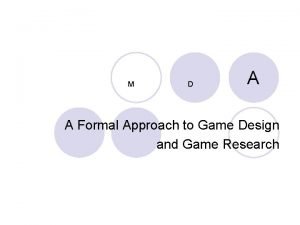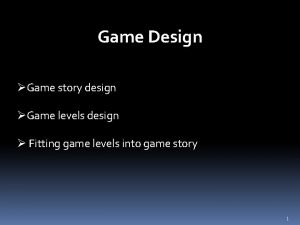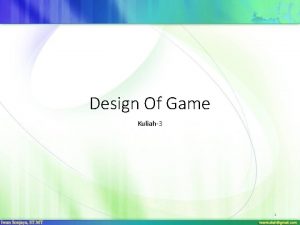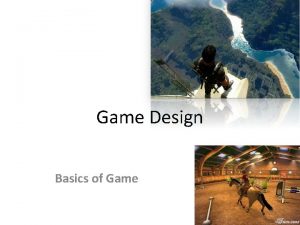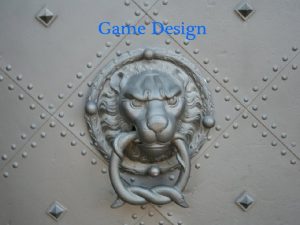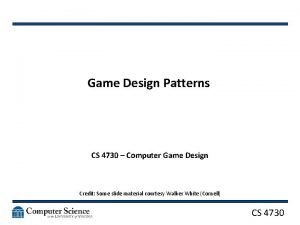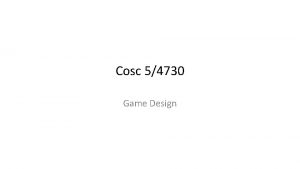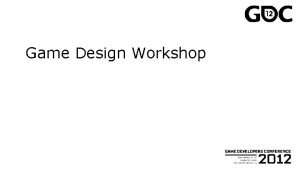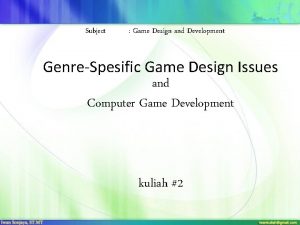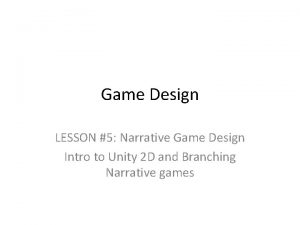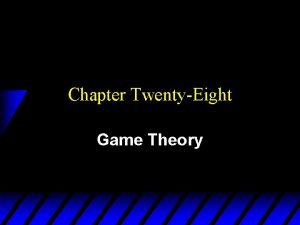How to Design a Game The Game Design


















- Slides: 18

How to Design a Game

The Game Design Cycle 1. Draft Genre/Audience 2. Themework 3. Model 4. Abstract 5. Test 6. Balance 7. Revise

Audience • Education • Who do they play with? • How do they obtain games? • What other games do they play? • When do they play? • How much time do they have? • Affluence • Geographic location

Theme Step 1. Choose a theme 2. Brainstorm 3 a. Select best elements 3. Identify the essence Example James Bond. . . Secret Agent Gadgets, laser watch, car chases, seduction, missions, berretta, evil genius, torture, gambling, license to kill, martini, champagne, caviar, exotic locations, save the world, disguise, alias, reparte • Be the best • Have the best • Surprise everyone with how good you/it is E

Model • Quantify thematic elements • Introduce classifications • Avoid one-offs • (but exception rules OK) • Complexity is OK • Do not attempt to balance now Size, Health, Weight, Damage, Range, Value, Material, Movement Rate, Location, Attack type, Growth rate. . . Flammable, Portable, Extensible, Living, Buoyant, Mountable, . . .

Abstract • Combine similar properties • Combine categories • Remove whole thematic elements • Board games require more absraction than video games

• • Model accurate units and locations? • Civilization: No • Advance Wars: Partly • Age of Empires: Yes Model seasons? • Harvest Moon: No

Test • Build prototype (quickly!) • Record quantifyable aspects • Note over- and under-used elements • Debrief players for qualitative aspects • Focus on positive first

Don’t take complaints at face value! “Pistols are too powerful, ” might really mean: “armor is too weak” “pistols are too available” “money is too available” “other options are not powerful enough” • Balance (1): everyone agrees pistols are balanced. • Balance (2): as many people think pistols are overpowered as underpowered.

Balance Testing identified imbalance. Now solve mathematically for viable structures and value ranges. Criteria: • Fairness • Stability • Engagement

Revise • Adjust quantitative factors for balance. • Can we afford full production on this design? • Would another theme change better fit the new mechanics? • Is there a more appropriate target audience? • Is there too little, or too much complexity?

How to Design Anything

The Game Design Cycle 1. Draft genre/audience 2. Choose theme 3. Model 4. Abstract 5. Test 6. Analyze 7. Revise

The Design Cycle 1. Draft requirements 2. Select elements 3. Model 4. Abstract 5. Test 6. Analyze 7. Revise

The Engineering Cycle 1. Draft requirements 2. Choose broad form 3. Model forces 4. Create subsystems 5. Build prototype 6. Analyze prototype 7. Revise

The Painting Cycle 1. Draft subject, medium 2. Preliminary sketches 3. Compose elements 4. Control emphasis 5. Rough in 6. Critique 7. Revise

The Software Cycle 1. Draft requirements 2. Choose features 3. Model, choose paradigm 4. Create APIs 5. Test 6. Profile and Debug 7. Patch

The Writing Cycle 1. Choose audience, form 2. Brainstorm world 3. Sketch plot and characters 4. Remove detail 5. Draft and solicit feedback 6. Analysis and editor feedback 7. Author editing
 A formal approach to game design and game research
A formal approach to game design and game research Hát kết hợp bộ gõ cơ thể
Hát kết hợp bộ gõ cơ thể Frameset trong html5
Frameset trong html5 Bổ thể
Bổ thể Tỉ lệ cơ thể trẻ em
Tỉ lệ cơ thể trẻ em Gấu đi như thế nào
Gấu đi như thế nào Chụp tư thế worms-breton
Chụp tư thế worms-breton Bài hát chúa yêu trần thế alleluia
Bài hát chúa yêu trần thế alleluia Các môn thể thao bắt đầu bằng tiếng đua
Các môn thể thao bắt đầu bằng tiếng đua Thế nào là hệ số cao nhất
Thế nào là hệ số cao nhất Các châu lục và đại dương trên thế giới
Các châu lục và đại dương trên thế giới Công thức tính độ biến thiên đông lượng
Công thức tính độ biến thiên đông lượng Trời xanh đây là của chúng ta thể thơ
Trời xanh đây là của chúng ta thể thơ Cách giải mật thư tọa độ
Cách giải mật thư tọa độ Phép trừ bù
Phép trừ bù độ dài liên kết
độ dài liên kết Các châu lục và đại dương trên thế giới
Các châu lục và đại dương trên thế giới Thơ thất ngôn tứ tuyệt đường luật
Thơ thất ngôn tứ tuyệt đường luật Quá trình desamine hóa có thể tạo ra
Quá trình desamine hóa có thể tạo ra
